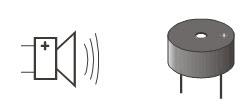Activity 3: Start-Reset Indicator
In this activity, we’ll build a small noise-making circuit on the BOE Shield’s prototyping area that will generate a tone if the robot’s batteries run too low.
When the voltage supply drops below the level a device needs to function properly, it’s called brownout. The device (your Arduino) typically shuts down until the supply voltage returns to normal. Then, it will restart whatever sketch it was running.
Brownouts typically happen when batteries are already running low, and the servos suddenly demand more power. For example, if the BOE Shield-Bot changes from full speed forward to full speed backward, the servos have to do extra work to stop the servos and then go the other direction. For this, they need more current, and when they try to pull that current from tired batteries, the output voltage dips enough to cause brownout.
Now, imagine your BOE Shield-Bot is navigating through a routine, and suddenly it stops for a moment and then goes in a completely unexpected direction. How will you know if it is a mistake in your code, or if it’s a brownout? One simple, effective solution is to add a speaker to your BOE Shield-Bot and make it play a “start” tone at the beginning of every sketch. That way, if your BOE Shield-Bot has a brownout while it’s navigating, you’ll know right away because it’ll play the start tone.
We’ll use a device called a piezoelectric speaker (piezospeaker) that can make different tones depending on the frequency of high/low signals it receives from the Arduino. The schematic symbol and part drawing are shown below.

Frequency is the measurement of how often something occurs in a given amount of time.
A piezoelectric element is a crystal that changes shape slightly when voltage is applied to it. Applying high and low voltages at a rapid rate causes the crystal to rapidly change shape. The resulting vibration in turn vibrates the air around it, and this is what our ear detects as a tone. Every rate of vibration makes a different tone.
Piezoelectric elements have many uses. When force is applied to a piezoelectric element, it can create voltage. Some piezoelectric elements have a frequency at which they naturally vibrate. These can be used to create voltages at frequencies that function as the clock oscillator for many computers and microcontrollers.
